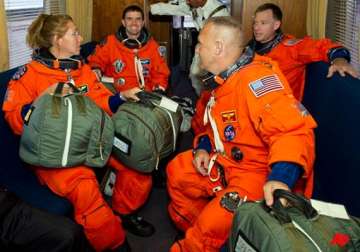Shuttle Astronauts Busy With Space Station Stockpiling
Cape Canaveral, Florida, Jul 11: The astronauts on NASA's final space shuttle flight got cracking Monday on all their supply delivery work, successfully hoisting a giant trunk out of Atlantis and attaching it to the

Cape Canaveral, Florida, Jul 11: The astronauts on NASA's final space shuttle flight got cracking Monday on all their supply delivery work, successfully hoisting a giant trunk out of Atlantis and attaching it to the International Space Station.
The 21-foot (6 1/2-meter) canister holds more than 4 tons of food, clothes and other provisions -- enough to keep the orbiting outpost and its residents in business for at least another year.
Shuttle astronauts Sandra Magnus and Douglas Hurley used the space station's hulking robot arm to hoist the Italian-built chamber, named Raffaello, out of Atlantis' payload bay first thing Monday morning. They moved it into position on the station and bolted it down, accomplishing the job an hour ahead of schedule.
The astronauts planned to open the hatch and enter Raffaello later in the day, and start removing all the trays and bags of supplies.
They also got some good news Monday: NASA no longer has any concern about a piece of space junk due to swing by Tuesday.
On Sunday, mission management team leader LeRoy Cain said controllers were monitoring the orbiting debris and that there was a chance it might come dangerously close. But on Monday, experts ascertained that the object -- a piece of an old Soviet-era satellite -- would remain at a safe distance and the shuttle-station complex would not need to move out of the way.
Mission Control said Sunday's docking by Atlantis actually lifted the joined vessels into a slightly higher orbit of 242 miles (390 kilometers) -- just enough to dodge the piece of junk.
Space junk is said to be the No. 1 threat facing the space station in the coming decade. More than 500,000 pieces of orbiting debris are being tracked, according to NASA. Two weeks ago, the six space station residents had to seek shelter in their lifeboats when a piece of junk came within 1,100 feet (335 meters) -- the closest encounter yet.
In another bit of welcome news, a critical shuttle computer was back up and running normally again after being knocked offline just before Sunday's linkup.
The 10 space fliers will spend the next week unloading the contents of Raffaello and filling the chamber back up with packing material, and space station garbage and old equipment.
Lead flight director Kwatsi Alibaruho said the back-and-forth load work by the astronauts will be like an army of ants moving in and out of their anthill.
NASA wants the space station well-stocked for the looming post-shuttle era. Private companies are working on rockets and spacecraft to deliver cargo, but that's still months away and there's always the chance of delays.
The ultimate goal -- in three to five years -- is for these same companies to ferry astronauts to and from the space station. Until then, NASA will keep shelling out tens of millions of dollars per seat aboard the Russian Soyuz spacecraft.
The two U.S. space station residents, meanwhile, will venture out on a spacewalk Tuesday. They will retrieve a broken ammonia pump and stash it aboard Atlantis for return to Earth late next week. Engineers want to figure out why it failed last year, to avoid future such breakdowns in orbit. The pair also will attach a robotic refueling experiment to the space station.
Four astronauts are flying on Atlantis and six on the space station. They represent the United States, Russia and Japan.
Atlantis is the last of NASA's three remaining shuttles to be retired, as the space agency turns its focus on expeditions to an asteroid and Mars. It will remain at Kennedy Space Center upon its return and be put on public display. AP